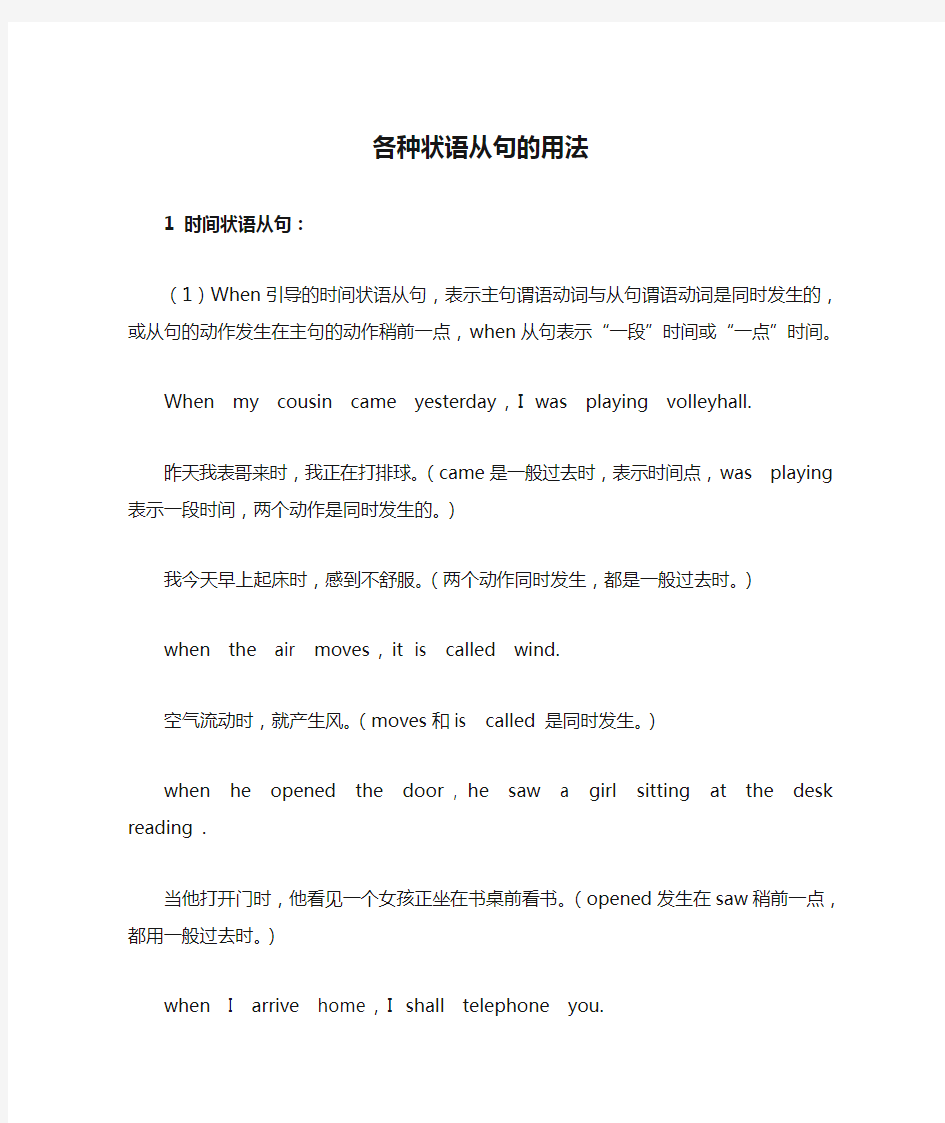各种状语从句的用法

- 1、下载文档前请自行甄别文档内容的完整性,平台不提供额外的编辑、内容补充、找答案等附加服务。
- 2、"仅部分预览"的文档,不可在线预览部分如存在完整性等问题,可反馈申请退款(可完整预览的文档不适用该条件!)。
- 3、如文档侵犯您的权益,请联系客服反馈,我们会尽快为您处理(人工客服工作时间:9:00-18:30)。
各种状语从句的用法
1 时间状语从句:
(1)When引导的时间状语从句,表示主句谓语动词与从句谓语动词是同时发生的,或从句的动作发生在主句的动作稍前一点,when从句表示“一段”时间或“一点”时间。When my cousin came yesterday , I was playing volleyhall.
昨天我表哥来时,我正在打排球。(came是一般过去时,表示时间点,was playing 表示一段时间,两个动作是同时发生的。)
我今天早上起床时,感到不舒服。(两个动作同时发生,都是一般过去时。)
when the air moves , it is called wind.
空气流动时,就产生风。(moves和is called 是同时发生。)
when he opened the door , he saw a girl sitting at the desk reading .
当他打开门时,他看见一个女孩正坐在书桌前看书。(opened发生在saw稍前一点,都用一般过去时。)
when I arrive home , I shall telephone you.
我到家时,将打电话告诉你。
(2) before引导的时间状语从句所表示的动作,发生在主句动作之后。如果强调主句动作的先完成,其谓语应用过去完成时,before引导的从句用一般过去时。如果不强调动作的先后,那么主句和从句的谓语用一般过去时。
he worked in Beijing before he came here.
他来这里之前在北京工作。(worked发生came在之前,但不强调先后,故用一般过去时。)He had already worked for five hours continuously before he took a rest.
在他休息之前,他已连续不断的工作了五个小时。
(强调主句had worked 的在前,故用过去完成时。)
I saw him before he left.
他离开前我见过他。(saw比left稍前一些,但不强调两者的前后,所以都用一般过去时。)She was at school before she became a barber.
当理发师之前她在念书。(was发生在前,became发生在后,但不强调先后,故用一般过去时。)
(3) after:用after引导的时间状语从句,所表示的动作发生在主句动作之前。如果强调动作的先后,after从句用过去完成时,主句用一般过去时,如果不强调先后而表示连续的动作,主句和从句用一般过去时。
after she finished her homework , she went to bed.
她完成了作业就去睡觉了。(表示一个动作接着一个动作,用一般过去时。)
This morning he got up early . he put on his clothes , washed his face , brushed his teeth and then had his breakfast.
After he had had breakfast he went to school.
(got, put on , washed , brushed ,had 都用一般过去时,因为是连续的动作。Had had 用过去完成时,因强调“吃饱”发生在went 之前。)
I shall write to you after I arrive in shanghai .
到上海后我将给你写信。(arrive这个动作先与shall write ,arrive 是以现在时代替将来时,不可改为shall arrive )
(4) while:用while引导的时间状语从句,强调主句的动作和从句的动作在某一时间内同时发生,意为“在。。。期间,在。。。过程中“。while引导的时间状语从句只能表示一段时间,
所以必须是可延续的动作。不能表示时间的点,所以不可也非延续性动词连用。
while they were having supper , I came to their home.
正当他们在吃饭时,我来到他们家。(were having是过去进行的动作,came是过去的一点动作。)
Father took care of the child while his wife was away.
妻子不在家时,父亲照顾小孩。(took care和was 都是一半过去时,表示同时发生。)
I was doing my homework while my mother was cooking.
我母亲在做饭时,我在做家庭作业。(was doing 和was cooking两个动作同时发生。)(5)until(till):till和until都表示“直到“,两个词常互换使用,用法有以下两种:
(1)如果主句谓语动词为非延续性,如come ,go ,enter ,return ,start ,reach ,finish ,stop 等,主句用否定式,从句用肯定式,如结构,意为“直到。。。。才“或”在。。。之前不“。she won’t go to bed , until / till her mother returns.
直到她母亲回来她才睡。(或“她母亲回来之前她不睡“。)
They didn’t leave the classroom until/till they finished their homework.
他们完成了家庭作业才离开教室。(或“在完成作业之前,他们没有离开教室“。)
We won’t start until peter comes.
要等到彼得来了,我们才开始。
(2)如果主句谓语为延续性动词,如stay ,wait ,read 等,主句和从句用肯定式,意为“直到。。。“。
I waited until/till she came back.
我一直等到她回来。
The children were playing in the playing until/till it was very dark.
孩子们在操场上一直玩到了天很黑。
He ran until he was breathless.
他一直跑道气喘嘘嘘。
(6) as:用as引导的时间状语从句表示“当。。。时“,”一边。。。。一边。。。。“,主句的动作和从句的动作通红司发生,as引导的时间状语从句既可表示一段时间(用延续性动词),也可以表示某一个时间点(用非延续性动词)
as we were walking in the street , it began to rain.
正当我们在街上走,天开始下起了雨。
I gave he the letter as she came out of the classroom.
当她走出教室时,我把信给了她。
She sang as she wet along.
她一边走一边唱歌。
When he was a child.
While he was a child. He lived in Beijing .
As he was a child.
当他是个小孩时,他住在北京。(可见as有时可与when和while换用)
(7)since:引导的时间状语从句意为“自。。。以来“。从句的动词表示动作的起点,用一般过去时。主句中的动词表示动作的延续情况,一般要用现在完成时,但要注意两点:
(1)如果主句中的动词是表示状态,而不是动作,可用一般现在时。
(2)在某种特定的上下文中,主句要用过去完成时,而不用现在完成时。
five years have passed since he began his work here.
